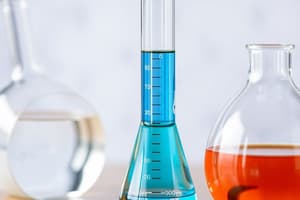Podcast
Questions and Answers
What is the first step in stoichiometric calculation to convert between masses?
What is the first step in stoichiometric calculation to convert between masses?
- Convert the mass of one substance to moles using its molar mass (correct)
- Identify the limiting reactant in the reaction
- Obtain the mole ratio from the balanced equation
- Convert moles of one substance to mass using its molar mass
In the stoichiometric process, why is it important to consider some species as being in excess?
In the stoichiometric process, why is it important to consider some species as being in excess?
- Excess species are always the reactants
- Excess species can provide more yield
- They can alter the reaction temperature significantly
- They do not affect the final product mass (correct)
How do you determine the number of moles of a substance from the balanced chemical equation?
How do you determine the number of moles of a substance from the balanced chemical equation?
- Through direct measurement of mass
- Using the ideal gas law
- By calculating the density of the solution
- Using the stoichiometric coefficients in the equation (correct)
What is the relationship between mass and moles in stoichiometry?
What is the relationship between mass and moles in stoichiometry?
What was a crucial factor for NASA engineers regarding the fuel for the space shuttles?
What was a crucial factor for NASA engineers regarding the fuel for the space shuttles?
What is the molar mass of oxygen used in stoichiometric calculations for combustion?
What is the molar mass of oxygen used in stoichiometric calculations for combustion?
In stoichiometry, what is typically the first unit conversion step when calculating amounts of substances?
In stoichiometry, what is typically the first unit conversion step when calculating amounts of substances?
What is the balanced equation for the reaction between hydrogen and oxygen to produce water?
What is the balanced equation for the reaction between hydrogen and oxygen to produce water?
During the combustion of hydrogen with oxygen, what is the main product formed?
During the combustion of hydrogen with oxygen, what is the main product formed?
How many tons of hydrogen does a space shuttle need for each ton of oxygen?
How many tons of hydrogen does a space shuttle need for each ton of oxygen?
What is the molar mass of oxygen (O2) used in the calculations?
What is the molar mass of oxygen (O2) used in the calculations?
Why did NASA engineers calculate the exact amount of reactants needed?
Why did NASA engineers calculate the exact amount of reactants needed?
What is the primary reaction product when hydrogen combusts with oxygen?
What is the primary reaction product when hydrogen combusts with oxygen?
What is one of the characteristics of the flames produced by hydrogen combustion?
What is one of the characteristics of the flames produced by hydrogen combustion?
To convert tons of oxygen to grams, what conversion must be applied if 1 ton is 2000 lb?
To convert tons of oxygen to grams, what conversion must be applied if 1 ton is 2000 lb?
How many moles of water are produced per mole of oxygen in the given reaction?
How many moles of water are produced per mole of oxygen in the given reaction?
What primarily influences the solubility of a solute in a solvent?
What primarily influences the solubility of a solute in a solvent?
Which type of force is present between nonpolar covalent molecules?
Which type of force is present between nonpolar covalent molecules?
Which statement accurately describes the relationship between polar solvents and solutes?
Which statement accurately describes the relationship between polar solvents and solutes?
What happens at equilibrium when an excess of solute is added to a solvent?
What happens at equilibrium when an excess of solute is added to a solvent?
How do ionic compounds interact with polar solvents?
How do ionic compounds interact with polar solvents?
What is the role of intramolecular forces in solubility concerning hydrogen bonding?
What is the role of intramolecular forces in solubility concerning hydrogen bonding?
What does ΔH represent in the context of the heat of solution?
What does ΔH represent in the context of the heat of solution?
Which of the following best describes 'like dissolves like'?
Which of the following best describes 'like dissolves like'?
What temperature in Celsius corresponds to absolute zero?
What temperature in Celsius corresponds to absolute zero?
Which statement about the kelvin scale is correct?
Which statement about the kelvin scale is correct?
In osmosis, where do solvent molecules move?
In osmosis, where do solvent molecules move?
If seawater is consumed, what physiological effect does it have on the body?
If seawater is consumed, what physiological effect does it have on the body?
What is the osmotic pressure based on?
What is the osmotic pressure based on?
What would be the molarity of NaOH if 10 grams is dissolved in 250 mL of water?
What would be the molarity of NaOH if 10 grams is dissolved in 250 mL of water?
What defines the point of osmotic pressure?
What defines the point of osmotic pressure?
Which of the following substances represents a low-molecular-mass starch?
Which of the following substances represents a low-molecular-mass starch?
What does Hess's law specifically state about the change in enthalpy for a chemical reaction?
What does Hess's law specifically state about the change in enthalpy for a chemical reaction?
Which scenario describes an exothermic process during a solution formation?
Which scenario describes an exothermic process during a solution formation?
In the context of solution concentration, what does molarity (M) specifically represent?
In the context of solution concentration, what does molarity (M) specifically represent?
How is the concentration of a solution generally described?
How is the concentration of a solution generally described?
What is the molarity of a solution created by dissolving 0.38 g of NaNO3 in 50.0 mL of water?
What is the molarity of a solution created by dissolving 0.38 g of NaNO3 in 50.0 mL of water?
Which quantitatively expresses a dilute solution?
Which quantitatively expresses a dilute solution?
When converting 0.38 g of NaNO3 to moles, what is the outcome?
When converting 0.38 g of NaNO3 to moles, what is the outcome?
What is the relationship between the heat effects and ideal solutions?
What is the relationship between the heat effects and ideal solutions?
Flashcards are hidden until you start studying
Study Notes
Stoichiometric Calculations
- Steps in converting masses of reactants and products:
- Convert the mass of substance A to moles.
- Use the balanced chemical equation to find the mole ratio of A to B.
- Convert the moles of substance B to mass.
- The US Space Shuttle example:
- NASA engineers used stoichiometry to calculate fuel requirements for the space shuttles.
- Reaction: 2H2(g) + O2(g) → 2H2O(g)
- To calculate hydrogen needed for 1.00 tn of oxygen:
- Convert tons of O2 to grams.
- Calculate moles of O2.
- Use mole ratio to find moles of H2.
- Convert moles of H2 to tons.
Solutions
- The solubility of a solute in a solvent depends on the balance between the natural tendency for solute and solvent to mix, and achieving the lowest energy possible.
- The concentration of a solute is the amount dissolved per unit volume of solution or solvent.
- When a solute dissolves in a solvent, an equilibrium is established between the undissolved and dissolved solute.
- Polar liquids can act as solvents for ionic compounds.
- Ion-dipole interactions are strong and contribute to dissolving ionic compounds in polar liquids.
- Phospholipids form a bilayer in the cell membrane, with hydrophobic tails towards the interior and hydrophilic heads facing the exterior.
Heat of Solution
- Energy (heat) is absorbed or evolved when a solute dissolves in a solvent.
- The heat effect observed in preparing a solution is due to breaking and forming bonds and attractions between solute-solute, solvent-solvent, and solute-solvent.
- Enthalpy change (ΔH) denotes the heat change in a process between initial and final states.
- Hess's law states that the overall enthalpy change in a reaction is the sum of enthalpy changes for each step.
- Solutions can be exothermic (heat evolved) or endothermic (heat absorbed).
- Ideal solutions mix without heat change.
Molarity
- Concentration refers to the quantity of solute in a standard quantity of solution.
- A solution is dilute when the solute concentration is low and concentrated when it's high.
- Molarity (M) is the moles of solute dissolved in 1 liter of solution.
- Molarity is a measure of concentration.
Calculating Moles from Volume
- The flowchart for stoichiometric calculations can use either masses of solid reactants/products or volumes of solutions of reactants/products to determine amounts of other species.
Temperature: Random Motion of Molecules and Atoms
- Absolute Zero is -273.15 °C or -459.7 °F, where molecular motion virtually stops.
- Kelvin (K) is the same size as the Celsius degree, but with zero set at a different point.
- Temperature scales can be converted using formulas:
- °C = (K - 273.15)
- °F = (9/5)°C + 32
- K = °C + 273.15
Osmosis
- Osmosis is the movement of solvent molecules through a semipermeable membrane from a dilute solution to a more concentrated solution.
- In biology, osmosis is the movement of water molecules across a cell's partially permeable membrane.
- Drinking seawater or saltwater causes dehydration due to osmosis, as water moves out of the body to try to balance the salt concentration.
Osmotic Pressure
- Osmotic pressure (π) is a colligative property of a solution that stops osmosis.
- Osmotic pressure is related to the molar concentration of solute (M) by the equation: π = MRT, where R is a constant (0.082 L.atm/K.mol) and T is the absolute temperature.
Studying That Suits You
Use AI to generate personalized quizzes and flashcards to suit your learning preferences.




